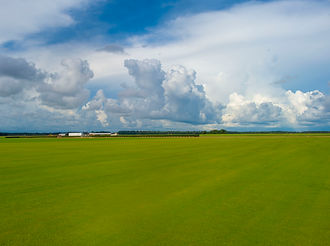top of page
Conservation of Honey Bees
Why Honey Bees?
As referenced before, honey bees are a large part of the agricultural industry and directly affect the quality and yield of 75 percent of crop types. Without pollination, approximately 5–8% of global crop production would be lost (Nicholls et. al., 2020), with mainly cereals and wheat remaining unaffected. Not only will this cause a shortage of nutritious and diverse food, but it would also require new techniques to be employed and an increase in land use (Wilson-Rich, 2014). Though all bees disappearing suddenly is not a possible scenario, we have been seeing a steady decrease in the number of hives, and that rate has been increasing in the past 20 years due to colony collapse disorder. Most people who have a stakehold in the agricultural or animal industries rightly would be concerned about the decline of something that plays a large role in their livelihood.
Though honey bees are most known for their agricultural contributions, they are also a cultural symbol and a source of beekeeping products. Since ancient Mesopotamia, honey bees have been a part of human society. Honey has been utilized as a food source, sealant, food preserver, and even for mummification.

Worker honey bee gathering pollen and nectar
Agrochemicals:

Plane spraying pesticides on field
Since the 1940s, the agricultural industry has depended significantly on pesticides and herbicides to increase farming efficiency and productivity. While pesticides are effective in removing unwanted insects, they are usually harmful to honey bees as well (Wilson-Rich, 2014). In recent years, some pesticides have been designed to not harm honey bees, but these only work if the honey bees ingest it in low quantities. Farmers typically use planes to quickly disperse agrochemicals across a field. The issue is that many of the chemicals are vulnerable to wind drift which result in large amounts of unwanted chemicals being deposited on nearby hives. If there are many hives close to one another, this could lead to devastating losses. Even if bees ingest normal amounts of pesticides, it in combination with other chemicals fed to them to resist pests and pathogens, can weaken their immune systems.
Pests and Pathogens:
While a variety of pathogens and pests are harmful to honey bees, however, one of the most recent and well-known threats is colony collapse disorder (CCD). A hive experiencing CCD is characterized by a sudden loss of most of the adult worker bees, leaving behind the queen, food, and a few of the younger worker bees (Wilson-Rich, 2014). There is no apparent cause for these sudden disappearances since dead bees are not usually found near the hive. CCD was first noticed in the United States in 2006 and was met with a large increase in hives that didn't survive the winter. Though it is still present today, it is much less severe (USDA, 2021).
More common causes of hive death are pests like varroa mites and hive beetles. Since their introduction to the United States from Asia in 1987, Varroa mites have been one of the most serious dangers to honey bees.(USDA, 2021). Varroa mites tend to feed on the older brood, or eggs, and act like mosquitoes, sucking out their blood and giving the bees debilitating viruses. Varroa is particularly dangerous because it reproduces quickly and weakens the hive, leaving it more vulnerable to infections and CCD. (USDA, 2021). Varroa mite prevention is one of the highest costs to beekeepers, and without it, uncontrolled varroa can kill a hive within two years (Genersch, 2010).
Other pests and pathogens, like hive beetles, are just as common, and while typically not as deadly, they still pose a large threat to hive health. These threats have been the top reasons for the recent increase in hive death. Not only does this impact farmers, but it presents an increased cost and maintenance time for beekeepers. With threats like varroa, it becomes harder and harder for the average person to keep bees and have a hive live for more than a year.

Young worker honey bee with a varroa mites on her back
Poor nutrition:
Though some bees can sustain themselves on a single flower species, honey bees are not those kinds of bees. They are a very generalist species and need a diverse selection of flowers to pollinate and feed on. For honey bees that are meant to pollinate crops, they are oftentimes only gathering from one or two plants. Like humans, if they eat the same thing every day, they won't get all the nutrients that they need. This weakens their immune system and leaves them susceptible to more diseases (USDA, 2021). This is exacerbated by the use of herbicides that kill all plants other than the intended crop. This makes the bee’s foraging area more monocultured and removes nutritious plants like clover. For bees that live in urban areas, the same problem of monoculture arises. With the loss of land increasing, non - native honey bees encroach more on native bee territory and reduce potential pollination areas for both types of bees.

Example of a monoculture landscape commonly found on commercial farms
Challenging Alternative Positions
Opponents of focusing on just honey bees argue that honey bees are actually invasive species to North America and they should be limited to just pollinating agricultural land. While it is true that they are not native to North America, they are an important part of many indigenous peoples' cultures. Honey bees were brought over from Europe so long ago that they have integrated themselves into ecosystems here. To completely remove them will be equivalent to completely removing a native bee species. In environments where native bees may be struggling to effectively pollinate, honey bees can help supplement them. Moreover, honey bees are able to split their hive if they get too big, making it nearly impossible to "constrain" them to one area.
bottom of page
